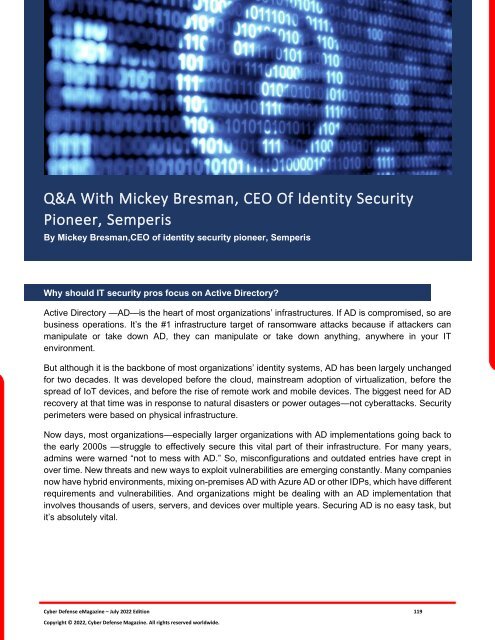Cyber Defense eMagazine July Edition for 2022
Cyber Defense eMagazine July Edition for 2022 #CDM #CYBERDEFENSEMAG @CyberDefenseMag by @Miliefsky a world-renowned cyber security expert and the Publisher of Cyber Defense Magazine as part of the Cyber Defense Media Group as well as Yan Ross, Editor-in-Chief and many more writers, partners and supporters who make this an awesome publication! Thank you all and to our readers! OSINT ROCKS! #CDM #CDMG #OSINT #CYBERSECURITY #INFOSEC #BEST #PRACTICES #TIPS #TECHNIQUES
Cyber Defense eMagazine July Edition for 2022 #CDM #CYBERDEFENSEMAG @CyberDefenseMag by @Miliefsky a world-renowned cyber security expert and the Publisher of Cyber Defense Magazine as part of the Cyber Defense Media Group as well as Yan Ross, Editor-in-Chief and many more writers, partners and supporters who make this an awesome publication! Thank you all and to our readers! OSINT ROCKS! #CDM #CDMG #OSINT #CYBERSECURITY #INFOSEC #BEST #PRACTICES #TIPS #TECHNIQUES
You also want an ePaper? Increase the reach of your titles
YUMPU automatically turns print PDFs into web optimized ePapers that Google loves.
Q&A With Mickey Bresman, CEO Of Identity Security<br />
Pioneer, Semperis<br />
By Mickey Bresman,CEO of identity security pioneer, Semperis<br />
Why should IT security pros focus on Active Directory?<br />
Active Directory —AD—is the heart of most organizations’ infrastructures. If AD is compromised, so are<br />
business operations. It’s the #1 infrastructure target of ransomware attacks because if attackers can<br />
manipulate or take down AD, they can manipulate or take down anything, anywhere in your IT<br />
environment.<br />
But although it is the backbone of most organizations’ identity systems, AD has been largely unchanged<br />
<strong>for</strong> two decades. It was developed be<strong>for</strong>e the cloud, mainstream adoption of virtualization, be<strong>for</strong>e the<br />
spread of IoT devices, and be<strong>for</strong>e the rise of remote work and mobile devices. The biggest need <strong>for</strong> AD<br />
recovery at that time was in response to natural disasters or power outages—not cyberattacks. Security<br />
perimeters were based on physical infrastructure.<br />
Now days, most organizations—especially larger organizations with AD implementations going back to<br />
the early 2000s —struggle to effectively secure this vital part of their infrastructure. For many years,<br />
admins were warned “not to mess with AD.” So, misconfigurations and outdated entries have crept in<br />
over time. New threats and new ways to exploit vulnerabilities are emerging constantly. Many companies<br />
now have hybrid environments, mixing on-premises AD with Azure AD or other IDPs, which have different<br />
requirements and vulnerabilities. And organizations might be dealing with an AD implementation that<br />
involves thousands of users, servers, and devices over multiple years. Securing AD is no easy task, but<br />
it’s absolutely vital.<br />
<strong>Cyber</strong> <strong>Defense</strong> <strong>eMagazine</strong> – <strong>July</strong> <strong>2022</strong> <strong>Edition</strong> 119<br />
Copyright © <strong>2022</strong>, <strong>Cyber</strong> <strong>Defense</strong> Magazine. All rights reserved worldwide.


















